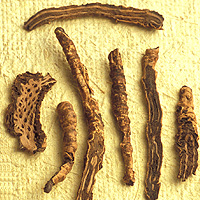Penn Herb Wellness Guide
Picrorhiza
 © Martin Wall
© Martin WallParts Used & Where Grown
The herb originated in and continues to grow primarily in the Himalayan mountains. The rhizomes or underground stems of picrorhiza are used.
- Reliable and relatively consistent scientific data showing a substantial health benefit.
- Contradictory, insufficient, or preliminary studies suggesting a health benefit or minimal health benefit.
- For an herb, supported by traditional use but minimal or no scientific evidence. For a supplement,little scientific support.
Our proprietary “Star-Rating” system was developed to help you easily understand the amount of scientific support behind each supplement in relation to a specific health condition. While there is no way to predict whether a vitamin, mineral, or herb will successfully treat or prevent associated health conditions, our unique ratings tell you how well these supplements are understood by the medical community, and whether studies have found them to be effective for other people.
For over a decade, our team has combed through thousands of research articles published in reputable journals. To help you make educated decisions, and to better understand controversial or confusing supplements, our medical experts have digested the science into these three easy-to-follow ratings. We hope this provides you with a helpful resource to make informed decisions towards your health and well-being.
This supplement has been used in connection with the following health conditions:
| Used for | Amount | Why |
|---|---|---|
Asthma | 400 to 1,500 mg of powdered root per day | Two preliminary trials have shown picrorhiza to improve asthma symptoms. |
Vitiligo | 400 and 1,500 mg of powdered rhizome | In one trial, picrorhiza, in combination with the drug methoxsalen and sun exposure, speeded recovery in people with vitiligo. |
Hepatitis | 1,600 mg daily | A series of cases of acute viral hepatitis were reported by one group in India, showing picrorhiza, combined with a variety of minerals, to be helpful in hastening recovery. |
Indigestion, Heartburn, and Low Stomach Acidity | Refer to label instructions | Boldo has been used in South America for a variety of digestive conditions. |
Infection | Refer to label instructions | Picrorhiza supports the immune system and protects against microbes. |
Rheumatoid Arthritis | Refer to label instructions | Studies conducted in India with the herb picrorhiza show a benefit for people with rheumatoid arthritis. |
Traditional Use (May Not Be Supported by Scientific Studies)
The bitter rhizomes of picrorhiza have been used for thousands of years in India to treat people with indigestion.1 It is also used to treat people with constipation due to insufficient digestive secretion and for fever due to all manner of infections.2
Copyright 2026 TraceGains, Inc. All rights reserved.
Learn more about TraceGains, the company.
The information presented by TraceGains is for informational purposes only. It is based on scientific studies (human, animal, or in vitro), clinical experience, or traditional usage as cited in each article. The results reported may not necessarily occur in all individuals. Self-treatment is not recommended for life-threatening conditions that require medical treatment under a doctor's care. For many of the conditions discussed, treatment with prescription or over the counter medication is also available. Consult your doctor, practitioner, and/or pharmacist for any health problem and before using any supplements or before making any changes in prescribed medications. Information expires December 2026.


